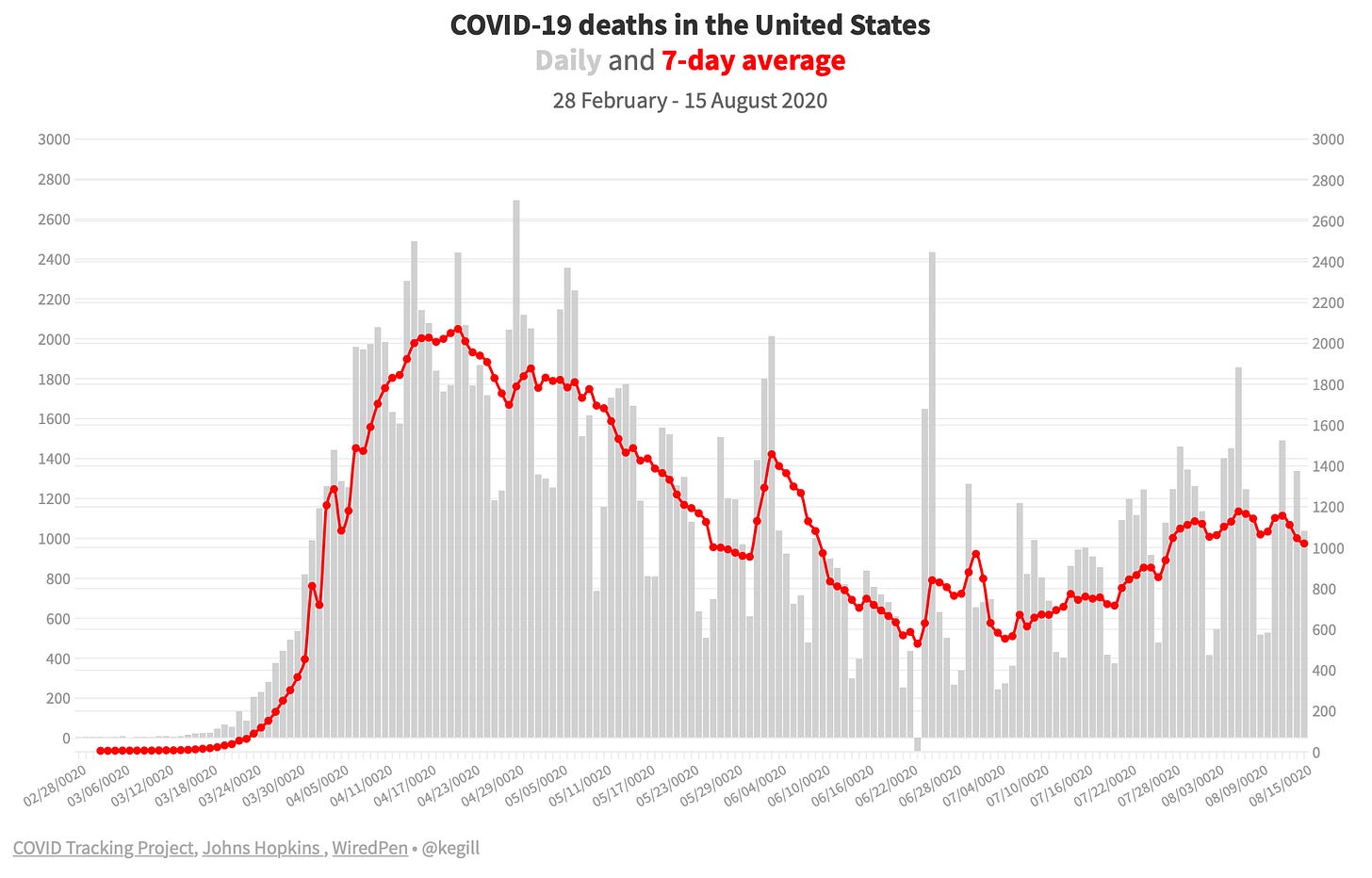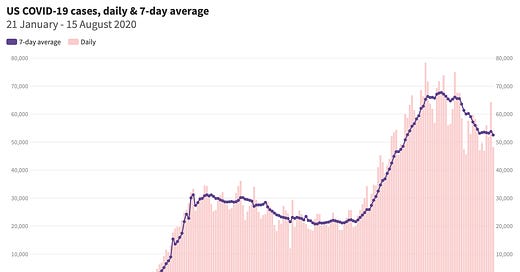COVID-19 day 207: 📈 64,201 new cases, 1,336 new deaths (US): 14 August 2020
This is not the rollercoaster that I want to be riding. Speaker Pelosi calls for USPS day of action on Tuesday as she reconvenes the House. NZ locks down Auckland after 30 cases are IDed.

Friday was day 207 since the first case of coronavirus disease was announced in the United States. Because so many states are no longer reporting data on Saturday and Sunday, I am shifting data reports to M-W-F. I will probably continue to publish Tu-Th-Su. I may increase frequency as we near November to report on COVID-19 impacts on the election and voting. I will compare Monday’s data with Friday’s reports.
Seven-day averages have never been as important as they are now. Daily data reports are important but are no longer the most important news about COVID-19 in the United States as we continue to trail the developed world in our response to the pandemic.
Sections (no jump links, sorry!)
1, One big thing; 2, Key metrics; 3, Recommendations; 4, Politics, economics & COVID;
5, Resources
⓵ One big thing - the state of the virus
Despite the roller coaster of cases that leads this issue, which is quite frankly scary as hell, the death rate has fortunately not matched that from the spring.

Why are fewer people dying as a percentage of cases? Three hypotheses: hospitals are not as likely to be overloaded; doctors have learned more about the virus and treatment options; and we are testing more than the so-sick-they-must-be-hospitalized patient.
Added: a friend pointed out that ages are skewing younger as well. Thanks, Magnus.
Remember: until the very end of February, the White House clamped down on testing eligibility. To be tested, a patient had to have traveled to China or been in contact with someone who had traveled to China. On 29 February, officials in Washington State announced the first case of death due to community transmission. Subsequently, we’ve learned that there were earlier deaths.
The White House Coronavirus Task Force is “strongly recommend[ing]” that Georgia implement a statewide mask mandate because of “widespread and expanding community viral spread” of COVID-19.
The task force recommends restricting indoor dining at restaurants, now limited only by the number of diners who can be safely distanced six feet apart, to less than one-quarter of dining room capacity. Social gatherings, now capped at 50 people in Georgia, should be limited to 10 or fewer people.
Governor Kemp, who earlier this year sued Atlanta to try to stop the city from requiring masks (he dropped the lawsuit Thursday), had this response:

On Friday, Georgia had a positivity rate of 12%, which exceeds both WHO (5%) and White House (10%) thresholds to reopen businesses.
Georgia (10.6M population) reported 3,227 new cases on Friday.
Georgia was one of the last states to institute a stay-at-home order and was the first to reopen businesses.
“Georgia is very much the poster child for what happens when leadership take a hands-off approach to managing a pandemic. There are clear policies and practices that we know work to control this pandemic. Candidly, we’re not doing any of those things in our state,” Dr. Harry Heiman, a professor at Georgia State University's School of Public Health told USA Today.
Compare Georgia with New Zealand.
New Zealand (4.8M population) went 102 days with no new cases.
Last Tuesday, several members of a family in Auckland tested positive for coronavirus. With 30 new cases of COVID-19 - 30 cases - Prime Minister Jacinda Ardern has locked down the country’s largest city, Aukland. In addition, the country’s general election, originally scheduled for 19 September, is going to be delayed by four weeks.
Compare Georgia with Italy.
On Friday, Italy (60.5M population) reported 574 new cases. Starting Monday, Italy is mandating masks in public from 6pm - 6am and is implementing a three-week closure of nightclubs and dance halls. The closure also applies to outdoor venues where people might dance, such as beaches and common areas in hotels.
The death rate in the US is the 10th worst in the world; the case rate, the 8th worst.

The World Bank list of “high-income economies” has a population of 907 million, 2.7 times that of the United States. Since July, “69% of all new cases and 75% of all deaths recorded anywhere in the rich world came in the U.S., which accounts for 27% of the group's population.”
As a comparative case study, Georgia illustrates why.
⓶ Key metrics
🦠 Friday, Johns Hopkins reported 5,313,055 (64,201 new) cases and 168,446 (1,336 new) deaths, an increase of 1.22% and 0.80%, respectively, since Thursday. A week ago, the daily numbers increased by 1.19% and 0.78%, respectively.
Today
- seven-day average: 53,684 cases and 1,043 deaths
- 3.17% cases leading to death
- case rate, 160.5 per 10,000; death rate, 5.1 per 10,000One week ago
- seven-day average: 55,894 cases and 1,162 deaths
- 3.26% cases leading to death
- case rate, 149.3 per 10,000; death rate, 4.9 per 10,000
Note: the seven-day average is important because dailies vary due to factors other than actual case numbers, particularly over a weekend.
🇺🇸 14 August
CDC: 5,228,817 (52,799 new) cases & 166,317 (1,169 new) deaths
- One week ago: 4,858,327 (55,836 new) cases & 158,880 (1,249 new) deathsState data*: 5,280,137 (55,923 new) cases & 160,156 (1,217 new) deaths
- One week ago: 4,913,663 (61,520 new) cases & 152,816 (1,333 new) deaths
KS reports only M-W-F; CT and RI report only M-FWHO Situation report, 207
5 150 407 (55 907 new) cases and & 164 826 (xxx 1 486) deaths
- One week ago: 4 781 612 (53 373 new) cases & 157 357 (1 307 new) deaths
🌎 14 August
Johns Hopkins interactive dashboard (11.00 pm Pacific)
Global: 21,159,730 (253,839 new) cases & 764,683 (9,094 new) deaths
- One week ago: 19,378,036 (288,672 new) cases & 721,324 (6,580 new) deaths
* Johns Hopkins data, ~11.00 pm Pacific.
State data include DC, Guam, the Northern Mariana Islands, Puerto Rico and the US Virgin Islands
The virus was not created in a lab and the weight of evidence is that it was not released intentionally. Although early reports tied the outbreak to a market in Wuhan, China, analyses of genomic data have suggested that the virusdeveloped elsewhere.
⓷ Recommendations
🤓 Recommended reading
Health workers across the country looked on in horror when New York became the global epicenter of the coronavirus. Now, as physicians in cities such as Houston, Phoenix and Miami face their own COVID-19 crises, they are looking to New York, where the caseload has since abated, for guidance.
The Guardian sat in on a conversation with two emergency room physicians — one in New York and the other in Houston — about what happened when COVID-19 arrived at their hospitals.
‘Is This When I Drop Dead?’ Two Doctors Report From the COVID Front Lines. KHN, 14 August 2020.
Under the $675 million program, businesses and other entities were provided with supplies of the free, reusable masks that in some cases far exceeded their needs, according to a STAT review of an administration document identifying more than 60,000 recipients. A charter school with roughly 140 students in Florida, for instance, received 37,500 masks. In other cases, corporations with vast resources, including a Fortune 500 pharmaceutical company, also received tens of thousands of the masks.
The Trump administration haphazardly gave away millions of Covid-19 masks — to schools, broadcasters, and large corporations. STAT News, 13 August 2020.
“Some people think that public health measures are kind of the obstacle to opening up. They're not. They're a gateway,” said [Dr. Anthony] Fauci, director of the U.S. National Institute of Allergy and Infectious Diseases. “There is a golden mean in there—based on the guidelines that we carefully put together—about how you can open the country safely.”
What Fauci says the U.S. really needs to reopen safely. National Geographic, 13 August 2020.
Who protects the workers who keep the nation’s food supply running?
“Almost every part of the process for picking tomatoes needs to be considered in light of COVID-19,” said Ken Silver, an associate professor of environmental health at East Tennessee State University, who studies migrant worker health on Tennessee tomato farms.
After all, the workers live in close quarters, sleeping in bunk beds, and sharing bathrooms and kitchens. They ride crowded buses to fields and often work in groups. And even though farm employees are deemed essential workers, they often don’t have health insurance or paid sick leave.
Without Federal Protections, Farm Workers Risk Coronavirus Infection to Harvest Crops. KHN, 10 August 2020.
🔬 Research and medical news
Is the effort to rebut/refute/correct misinformation about health that you see on Twitter or Facebook worth the effort?
Interventions were more effective in cases where participants were involved with the health topic, as well as when misinformation was distributed by news organizations (vs. peers) and debunked by experts (vs. non-experts)…
Finally, the results suggest that it is more difficult to correct misinformation in the context of infectious disease as opposed to other health-related issues…
Misinformation shared by peers is more challenging to root out than misinformation from news organizations… Because we are more likely to perceive information sharing as an act of goodwill rather than persuasion from these sources, we tend to be less skeptical of the content.
Evaluating the Impact of Attempts to Correct Health Misinformation on Social Media: A Meta-Analysis. Journal of Health Communication, 06 August 2020.
⓸ Politics, economics and COVID-19
🆘 USPS removes mailboxes in Portland and Eugene, Oregon, citing “declining mail volume”
‼️ Day of action on Tuesday as Speaker Pelosi reconvenes the House

❌ Less than a week after starting fall term, UNC-Chapel Hill reported four COVID-19 clusters.
📣 Cardiologists are concerned that COVID-19 could cause heart complications that lead to sudden cardiac death in athletes.
🛑 Watch for Trump to push oleandrin as yet another unproven “coronavirus cure” at the urging of Ben Carson, Secretary of HUD, and MyPillow.com founder and CEO Mike Lindell, who is, you guessed it, a major Trump donor.
🦠 The US has no monopoly on “religious” leaders thumbing their nose at COVID-19 measures. South Korea has accused a pastor “of violating self-isolation rules and obstructing contact tracing at a church where 240 infections have fuelled the country’s worst outbreak in over five months.”
⓹ Resources
👓 See COVID-19 resource collection at WiredPen.
📝 Subscribe to Kathy’s COVID-19 Memo :: COVID-19 Memo archives
🦠 COVID-19 @ WiredPen.com
📊 Visualizations: US, World
🌐 Global news (at WiredPen)



